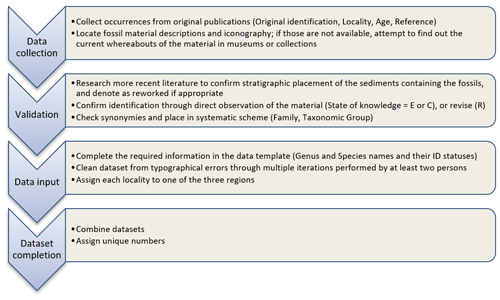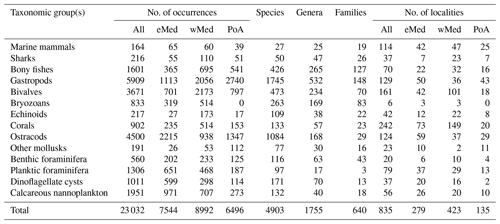the Creative Commons Attribution 4.0 License.
the Creative Commons Attribution 4.0 License.
A revised marine fossil record of the Mediterranean before and after the Messinian salinity crisis
Konstantina Agiadi
Niklas Hohmann
Elsa Gliozzi
Danae Thivaiou
Francesca R. Bosellini
Marco Taviani
Giovanni Bianucci
Alberto Collareta
Laurent Londeix
Costanza Faranda
Francesca Bulian
Efterpi Koskeridou
Francesca Lozar
Alan Maria Mancini
Stefano Dominici
Pierre Moissette
Ildefonso Bajo Campos
Enrico Borghi
George Iliopoulos
Assimina Antonarakou
George Kontakiotis
Evangelia Besiou
Stergios D. Zarkogiannis
Mathias Harzhauser
Francisco Javier Sierro
Angelo Camerlenghi
Daniel García-Castellanos
The Messinian salinity crisis and its precursor events have been the greatest environmental perturbation of the Mediterranean Sea to date, offering an opportunity to study the response of marine ecosystems to extreme hydrological change and a large-scale biological invasion. The restriction of the marine connection between the Mediterranean and the Atlantic Ocean resulted in stratification of the water column and high-amplitude variations in seawater temperature and salinity already from the early Messinian. Here, we present a unified and revised marine fossil record of the Mediterranean (https://doi.org/10.5281/zenodo.13358435, Agiadi et al., 2024) that covers the Tortonian stage, the pre-evaporitic Messinian stage, and the Zanclean stage and encompasses 23 032 occurrences of calcareous nannoplankton, dinoflagellates, foraminifera, corals, ostracods, bryozoans, echinoids, mollusks, fishes, and marine mammals. This record adheres to the FAIR principles, is updated in terms of taxonomy, and follows the currently accepted stratigraphic framework. Based on this record, knowledge gaps are identified, which are due to spatiotemporal inconsistencies in sampling effort and the distribution of sedimentary facies, as well as the inherent differences in the preservation potential between the groups. Additionally, sampling bias in old records may have distorted the record in favor of larger, more impressive taxa within groups. This record is now ready to be used to answer both geological and biological questions about the Mediterranean Sea and beyond and is amendable when new fossil data are brought to light.
- Article
(2104 KB) - Full-text XML
- BibTeX
- EndNote
The Mediterranean Sea is one of the areas of the world suffering today from an increased rate of warming as well as the immigration of warm-water non-indigenous species from the Red Sea through the Suez Canal (Galil, 2000; Marcott et al., 2013). However, there are no time series of monitoring data that are long enough to contain periods in the past when climate was equally warm, as future projections foretell, or when the Mediterranean was connected to other oceanic basins. As a result, we cannot currently establish with great certainty ecological thresholds and evaluate the resilience of the Mediterranean marine ecosystem to the anticipated change.
The Tortonian–Zanclean was a pivotal period in the evolution of the Mediterranean realm, predominantly due to the changes in the marine gateway configurations that affected the hydrological budget and oceanographic conditions in the basin, leading to the Messinian salinity crisis (MSC; Hsü et al., 1973). Even though the Neogene Mediterranean has been one of the most intensely researched geoscience topics in the last 150 years, its fossil record is largely fragmented and outdated, both in terms of taxonomy and stratigraphy. This has prevented the assessment of the implications of the MSC at the regional and global scales. Here, we provide a database of the revised marine fossil record of the Mediterranean Basin, before and after the MSC. The fossil record during the MSC has been addressed in previous work (Carnevale et al., 2019; Carnevale and Schwarzhans, 2022) and is not included here because it is much more limited spatially and temporally and cannot be used to assess large-scale changes statistically. This open-access dataset adheres to the FAIR (findable, accessible, interoperable, and reusable) principles (Wilkinson et al., 2016). It can be enlarged and amended in the future to enhance our understanding of the response of marine ecosystems to large-scale connectivity changes. It includes marine species occurrences in the Mediterranean Sea during the Tortonian age (13.8–7.25 Ma), the pre-MSC Messinian (7.25–5.97 Ma), and the Zanclean age (5.33–3.6 Ma) for the following groups: calcareous nannoplankton, dinocysts, foraminifera, corals, ostracods, bryozoans, echinoids, mollusks, fishes, and marine mammals.
In order to construct this dataset, we relied on the paleontological work conducted across the Mediterranean by generations of scientists, which included mapping, field collection and taphonomic observations, systematic identification and documentation of the fossil material, chronostratigraphy, and paleoenvironmental reconstructions. Most of these studies, which are available as separate papers dealing with each topic, were published over several years or even decades for each location. There have been a few reviews of the fossil record for some groups, but these are now in need of revision because both the stratigraphic framework and the systematic schemes have changed since their publication. Such studies include Benson (1976a) for ostracods, Cita (1976) for planktic foraminifera, Sorbini and Tirapelle Rancan (1980) for Messinian fishes, Moissette and Pouyet (1987) for bryozoans, Néraudeau et al. (2001) for irregular echinoids, and Monegatti and Raffi (2010) for Messinian gastropods and bivalves. None of these studies provided a dataset with the occurrences and only reviewed the previous literature. This dataset is unique because it consists of georeferenced occurrences of species-level-identified fossil material and includes the level of uncertainty, which is necessary for quantifying ecological impacts at regional and global level.
We collected the published fossil records of marine taxa in the Tortonian, the pre-evaporitic Messinian, and the Zanclean (Agiadi et al., 2024). For each record, the database includes the name of the taxon as in the original publication, the higher taxonomic group and the family it belongs to, the locality where it was found, the relative age of the sediments (separated into the three above categories), the publication(s) providing evidence for the occurrence, and the initials of the experts who collected and input the data (as given in the author contribution statement) (Fig. 1).
An occurrence was defined by the unique combination of three components: taxon, locality, and age. To facilitate future analyses at the genus and species levels, since we reported fossil occurrences at all taxonomic levels, we indicated the genus and species identification status for each record. When the record was in open nomenclature, we indicated this as having an uncertain (U) identification status of the species and/or the genus. However, when a species was described as a different morphotype but not named as a new species (e.g., sp. 1, sp. A), we treated it as a separate species if the corresponding expert(s) judged that the fossil material most probably belonged to a different, yet unnamed, species.
Locality refers to the distinct geographical site, where fossils were collected. Often it was not possible to locate the origin of each record precisely, to the outcrop level, because several records were published many decades ago, and the outcrops had since then been destroyed and the authors are deceased. We therefore retained the most specific information we could find based on the description of the locality in the publication. The coordinates of the localities were obtained either from the occurrence publication or by estimation based on the locality description. Each locality was assigned to one of three regions based on their paleogeographic placement in the western Mediterranean (wMed), the eastern Mediterranean (eMed), and the Po Plain–northern Adriatic (PoA), following the currently accepted paleogeographic data (Amadori et al., 2018; Steininger and Rögl, 1984). The PoA region developed as a paleoceanographic sub-basin of the Mediterranean in the Tortonian–early Messinian, as evidenced by its distinct strontium isotopic signature (Cornacchia et al., 2021) and the absence of halite deposits. To facilitate comparisons, apart from the Messinian and Zanclean records, we also placed the Tortonian records from Piedmont and the Po Plain within the PoA region. Based on the Late Miocene paleogeographic evolution of Calabria and Sicily (Butler et al., 1995; Caracciolo et al., 2013; Henriquet et al., 2020), we included the records from these areas as part of the eMed, since the marine connection with the wMed was located near its present location, possibly along present southern Sicily (Micallef et al., 2019) or at the Sicily Channel (Malta Plateau; Bache et al., 2012). When the exact coordinates for a locality had not been published or when the locality was too vague (e.g., Libya), we included approximate coordinates based on the description of the locality in the original publication.
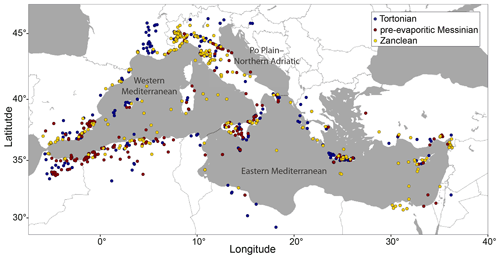
Figure 2Mediterranean map with the localities included in this record. Dashed lines show the borders between the three regions: western Mediterranean, eastern Mediterranean, and Po Plain–northern Adriatic. The coordinates of the localities were obtained from the original publications, whenever possible. The map was produced using ggmap (Kahle and Wickham, 2013).
The validity of each record was then assessed by the corresponding expert(s), considering changes in the stratigraphic placement of the sedimentary formation from which it derived, new taxon synonymies or reassignment since the publication of the record, and previous misidentifications (leading to a revised name for that record if necessary) (Fig. 1). Taxonomy followed the World Register of Marine Species (WoRMS Editorial Board, 2024) and the systematic schemes of Kroh and Smith (2010) for echinoids, Nelson et al. (2016) for fishes, Marx et al. (2016) for cetaceans, and Berta et al. (2018) for pinnipeds. The state of knowledge was noted accordingly in each case as follows: E. when the identification was confirmed by the expert based on their own sample examination; C. when the identification was confirmed by the expert based on photographs of the material that are available in the literature; R. when the identification was revised by the expert in the present study; and L. when the identification was not confirmed due to lack of access to the fossil material and absence of photographs in the literature, and the record relied only on the literature references.
Regarding elasmobranchs, our dataset includes only sharks, because there is not enough information on the dental morphology of most extant rays (batomorphs). Many batomorph teeth forms are rarely represented in the literature. Teeth, often isolated, are the more common elasmobranch fossils, and comparative information from extant species is necessary to identify them. For several genera of rays, species-level identification of fossil teeth is further hindered by the broad intra-generic variability. In addition, whilst some historical collections of shark teeth from the Mediterranean Miocene and Pliocene have been extensively reviewed, providing at least an updated nomenclatural framework to build upon, the same does not apply for batomorphs.
The assembled dataset comprised 23 032 occurrences, including 4903 species, 1755 genera, and 640 families (Table 1; Fig. 2).
First of all, some taxonomic issues remain that can only be addressed with further basic research and accumulation of new fossil material through fieldwork. The identification of some species could not be confirmed (state of knowledge = L) because the material was never portrayed. Even new species were established, on occasion, in earlier works without descriptions or illustrations (nomina nuda; Doruk, 1979).
Some gaps are detected in the fossil record. Spatiotemporal gaps are attributed to (a) the spatial distribution of outcrops of Late Miocene–Early Pliocene deposits (Mascle and Mascle, 2012) and (b) socioeconomic and political conditions favoring research in the northwestern Mediterranean countries (Cappelletto and et al., 2021). The spatial distribution of the localities within the Mediterranean is strongly skewed toward the west and the north (Figs. 2–4; e.g., for mollusks, see Monegatti and Raffi, 2010). However, there are notable exceptions. For example, most Tortonian data on gastropods are derived from the eastern Mediterranean, whereas almost all Messinian and Zanclean localities are in the western sub-basin or the Po Plain–Northern Adriatic region (Table 1). On the other hand, fossils are rarer the larger the animal is. Only a single diverse shark tooth assemblage is currently known from the pre-evaporitic Messinian of the Mediterranean Basin, from the vicinities of Oran (Algeria; Arambourg, 1927). Similarly, the fossil record of pinnipeds from the Late Miocene–Early Pliocene of the Mediterranean Basin only consists of two Monachinae (Phocidae) species: Messiphoca mauritanica from the Messinian (during the MSC) of Algeria (de Muizon, 1981) and fragmentary remains of Pliophoca cf. etrusca from southern France, Italy, and Spain (Berta et al., 2015).
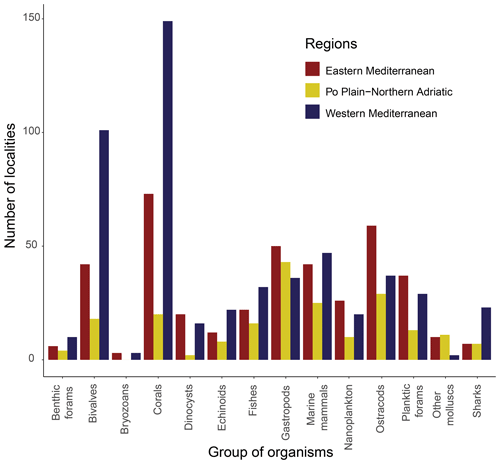
Figure 3Number of localities from where data were included in the database, by group of organisms and region.
Moreover, large species, especially those with more robust remains, have generally been favored in the fossil record of some groups, such as mollusks, as they were generally easier to sample (Dominici et al., 2020). This was in spite of the fact that a large proportion of the species in modern biodiversity hotspots are smaller than 4 mm (Bouchet et al., 2002). Particularly for the case of mollusks, bivalves (contrary to gastropods) include calcitic forms that have a higher preservation potential than aragonitic forms. In contrast to gastropods, there are many more pre-evaporitic Messinian localities with rich bivalve faunas than either Tortonian and Zanclean localities. This is largely due to a few large expeditions in northern Africa (Cornée et al., 2014; el Kadiri et al., 2010; Merzeraud et al., 2019), which however yielded only faunal lists of large-sized, mostly calcitic forms extracted from calcarenites, a lithology underrepresented in Zanclean collections (Dominici and Forli, 2021; Dominici et al., 2019).
Important gaps in the Late Miocene–Early Pliocene marine fossil record of the Mediterranean derive from the uneven distribution of the different facies. This especially affects the records of benthic organisms, whose distribution depends on the type of substratum. In the case of mollusks, knowledge of the onshore–offshore facies gradient is incomplete (Dominici and Forli, 2021; Dominici et al., 2019). As a result, for gastropods, Tortonian and Zanclean data represent a wider facies range, from onshore to offshore siliciclastic, whereas the pre-evaporitic Messinian data are mainly confined to open-shelf mudstones. Consequently, littoral and bathyal taxa of the pre-evaporitic Messinian may be underrepresented in the database. Moreover, the Messinian mollusk data include records from hybrid carbonates (e.g., Dominici et al., 2019), which are lacking in the Zanclean (Dominici and Forli, 2021). Such gaps do not appear consistently across groups, however: for ostracods, both shallow and deeper siliciclastic facies are represented from the three geographic areas and the three stratigraphic intervals, rendering the dataset rather more complete.
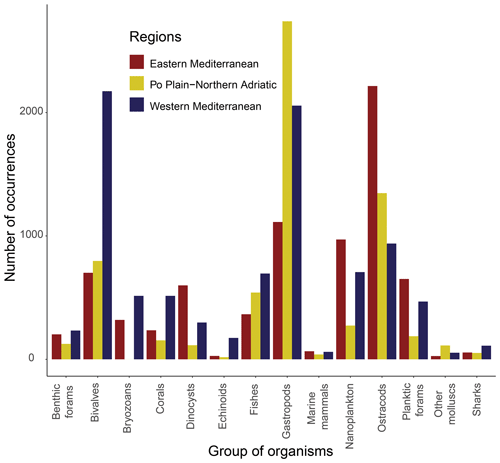
Figure 4Number of occurrences from where data were included in the database, by group of organisms and region.
Regarding stratigraphic gaps, the main issue when assembling the dataset derived from the fact that in some cases the chronostratigraphic framework provided in the initial publication was too broad (e.g., Late Miocene or Pliocene in general) or questionable because it was based on lithostratigraphic correlation (e.g., Benson, 1976b; Doruk, 1979; Sissingh, 1972). In the case of echinoids for example, many localities in the rich Italian Pliocene are generically reported in the geological maps and publications as “Zanclean–Piacenzian”, thus preventing the precise temporal collocation of numerous citations from the Argille Azzurre Formation of the PoA region (e.g., Airaghi, 1901; Botto-Micca, 1896) and from Tuscany (e.g., Desor, 1858; Meneghini, 1862). There are two different problems here: old citations rarely indicated the precise stratigraphic position, whereas several precise layers yielding echinoids have not been studied yet with modern methods. For the Pliocene, records were only included in the database if they could be securely placed in the Zanclean based on the current knowledge on the stratigraphic placement of the deposits they were recovered from. The result is a limited record for the Messinian and possibly the Zanclean, both potentially leading to an underestimation of echinoid diversity.
The dataset described in the paper is openly accessible under a CC BY license at https://doi.org/10.5281/zenodo.13358435 (Agiadi et al., 2024).
No code was used for assembling the database. The code to generate Table 1 and Figs. 2–4 is available at https://doi.org/10.5281/zenodo.13358742 (Hohmann and Agiadi, 2024).
This dataset includes a Tortonian–Zanclean marine fossil record of the Mediterranean before and after the Messinian salinity crisis. Initially, this dataset can be used to quantify the impact of the Messinian salinity crisis, which was the greatest paleoenvironmental perturbation of the Mediterranean, on marine biota. The Late Miocene–Early Pliocene Mediterranean fossil record is invaluable, not only for large-scale paleobiogeographic studies, but also for the evaluation of the indigenous/non-indigenous status of tropical marine species detected today in the eastern Mediterranean, establishing resilience thresholds for marine organisms and their ecosystems and investigating evolutionary dynamics, particularly of higher-trophic-level groups. Nevertheless, we highlight the need for further targeted sampling expeditions and collaborative paleontological investigations facilitated by science diplomacy (Soler and Perez-Porro, 2021) to fill in these spatial gaps in the fossil record of the Mediterranean.
KA: conceptualization, data curation, funding acquisition, investigation (data collection: bony fishes), methodology, project administration, writing (original draft preparation). NH: data curation, formal analysis, methodology, writing (review and editing). EG: investigation (data collection: ostracods), writing (review and editing). DT: data curation, investigation (data collection: bivalves, gastropods), writing (review and editing). FRB: investigation (data collection: corals), writing (review and editing). MT: investigation (data collection: corals), writing (review and editing). GB: investigation (data collection: marine mammals), writing (review and editing). AC: investigation (data collection: sharks), writing (review and editing). LL: investigation (data collection: dinoflagellates), writing (review and editing). CF: investigation (data collection: ostracods), writing (review and editing). FB: investigation (data collection: benthic foraminifera), writing (review and editing). EK: investigation (data collection: bivalves, gastropods), writing (review and editing). FL: investigation (data collection: calcareous nannoplankton), writing (review and editing). AMM: investigation (data collection: calcareous nannoplankton), writing (review and editing). SD: investigation (data collection: bivalves, gastropods), writing (review and editing). PM: investigation (data collection: bryozoans), writing (review and editing). IBC: investigation (data collection: echinoids), writing (review and editing). EB: investigation (data collection: echinoids), writing (review and editing). GI: investigation (data collection: marine mammals), writing (review and editing). AA: investigation (data collection: planktic foraminifera), writing (review and editing). GK: investigation (data collection: planktic foraminifera), writing (review and editing). EB: investigation (data collection: planktic foraminifera), writing (review and editing). SDZ: investigation (data collection: planktic foraminifera), writing (review and editing). MH: investigation (data collection: bivalves, gastropods), writing (review and editing). FJS: investigation (data collection: benthic foraminifera), writing (review and editing). AC: conceptualization, funding acquisition, writing (review and editing). DGC: conceptualization, funding acquisition, writing (review and editing).
The contact author has declared that none of the authors has any competing interests.
Publisher’s note: Copernicus Publications remains neutral with regard to jurisdictional claims made in the text, published maps, institutional affiliations, or any other geographical representation in this paper. While Copernicus Publications makes every effort to include appropriate place names, the final responsibility lies with the authors.
The authors would like to thank Fadl Raad and the anonymous reviewer for their constructive comments. Collaboration in this research was facilitated by the COST Action CA15103 “Uncovering the Mediterranean salt giant” (2016–2020). This research was funded in whole, or in part, by the Austrian Science Fund (FWF) (grant https://doi.org/10.55776/V986, available via https://www.fwf.ac.at/en/discover/research-radar, last access: 17 October 2024) (PI: Konstantina Agiadi). For the purpose of open access, the author has applied a CC BY public copyright license to any author accepted manuscript version arising from this submission. This is Ismar-CNR, Bologna, scientific contribution no. 2090. Konstantina Agiadi was also supported by Greek national funds and the European Social Fund through the action “Postdoctoral Research Fellowships” of the Greek National Scholarships Foundation, project “Comparative study of the Messinian Salinity Crisis effect on the eastern Ionian and northern Aegean ichthyofauna” (2017–2019). This research was co-funded by the European Union (ERC, MindTheGap, StG project no. 101041077). Views and opinions expressed are exclusively those of the author(s) and do not necessarily reflect those of the European Union or the European Research Council. Neither the European Union nor the granting authority can be held responsible for them. Elsa Gliozzi and Costanza Faranda were funded by MIUR-Italy, Department of Excellence Grant, Article 1, Paragraph 337, law 232/2016. This study was partially funded by the European Commission through ITN SaltGiant (Horizon2020-765256).
This research has been supported by the Austrian Science Fund (grant DOI 10.55776/V986).
This paper was edited by François G. Schmitt and reviewed by Fadl Raad and one anonymous referee.
Agiadi, K., Hohmann, N., Gliozzi, E., Thivaiou, D., Francesca, B., Taviani, M., Bianucci, G., Collareta, A., Londeix, L., Faranda, C., Bulian, F., Koskeridou, E., Lozar, F., Mancini, A. M., Dominici, S., Moissette, P., Bajo Campos, I., Borghi, E., Iliopoulos, G., Antonarakou, A., Kontakiotis, G., Besiou, E., Zarkogiannis, S. D., Harzhauser, M., Sierro, F., Camerlenghi, A., and Garcia-Castellanos, D.: Revised marine fossil record of the Mediterranean before and after the Messinian Salinity Crisis, Zenodo [data set], https://doi.org/10.5281/zenodo.13358435, 2024.
Airaghi, C.: Echinidi terziari del Piemonte e della Liguria, Palaeontol. Ital., 7, 22–126, 1901.
Amadori, C., Garcia-Castellanos, D., Toscani, G., Sternai, P., Fantoni, R., Ghielmi, M., and Giulio, A. D.: Restored topography of the Po Plain-Northern Adriatic region during the Messinian base-level drop–Implications for the physiography and compartmentalization of the palaeo-Mediterranean basin, Basin Res., 30, 1247–1263, https://doi.org/10.1111/bre.12302, 2018.
Arambourg, C.: Les poissons fossiles d'Oran, Matér, Pour Carte Géologique L'Algérie, 6, 1–218, 1927.
Bache, F., Popescu, S.-M., Rabineau, Gorini, C., Suc, J.-P., Clauzon, G. f, Olivet, J.-L., Rubino, J.-L., Melinte-Dobrinescu, M. C., Estrada, F., Londeix, L., Armijo, R., Meyer, B., Jolivet, L., Jouannic, G., Leroux, E., Aslanian, D., Reis, A. T. D., Mocochain, L., Dumurdžanov, N., Zagorchev, I., Lesić, V., Tomić, D., Namik Çagatay, M., Brun, J.-P., Sokoutis, D., Csato, I., Ucarkus, G., and Çakir, Z.: A two-step process for the reflooding of the Mediterranean after the Messinian Salinity Crisis, Basin Res., 24, 125–153, https://doi.org/10.1111/j.1365-2117.2011.00521.x, 2012.
Benson, R. H.: Changes in the ostracods of the Mediterranean with the Messinian salinity crisis, Palaeogeogr. Palaeocl., 20, 147–170, 1976a.
Benson, R. H.: Miocene deep-sea ostracodes of the Iberian Portal and the Balearic Basin, Mar. Micropaleontol., 1, 249–262, https://doi.org/10.1016/0377-8398(76)90010-4, 1976b.
Berta, A., Kienle, S., Bianucci, G., and Sorbi, S.: A Reevaluation of Pliophoca Etrusca (Pinnipedia, Phocidae) from the Pliocene of Italy: Phylogenetic and Biogeographic Implications, J. Vertebr. Paleontol., 35, e889144, https://doi.org/10.1080/02724634.2014.889144, 2015.
Berta, A., Churchill, M., and Boessenecker, R. W.: The Origin and Evolutionary Biology of Pinnipeds: Seals, Sea Lions, and Walruses, Annu. Rev. Earth Planet. Sci., 46, 203–228, https://doi.org/10.1146/annurev-earth-082517-010009, 2018.
Botto-Micca, L.: Contributo allo studio degli echinidi terziarii del Piemonte, Bolletino Soc. Geol. Ital., 15, 311–374, 1896.
Bouchet, P., Lozouet, P., Maestrati, P., and Heros, V.: Assessing the magnitude of species richness in tropical marine environments: exceptionally high numbers of molluscs at a New Caledonia site, Biol. J. Linn. Soc., 75, 421–436, https://doi.org/10.1046/j.1095-8312.2002.00052.x, 2002.
Butler, R. W. H., Lickorish, W. H., Grasso, M., Pedley, H. M., and Ramberti, L.: Tectonics and sequence stratigraphy in Messinian basins, Sicily: constraints on the initiation and termination of the Mediterranean salinity crisis, Geol. Soc. Am. B., 107, 425–439, https://doi.org/10.1130/0016-7606(1995)107<0425:TASSIM>2.3.CO;2, 1995.
Cappelletto, M., Santoleri, R., Evangelista, L., Galgani, F., Garces, E., Giorgetti, A., Fava, F., Herut, B., Hilmi, K., Kholeif, S., Lorito, S., Sammari, C., Campillos Lianos, M., Celussi, M., D'Alelio, D., Francocci, F., Giorgi, G., Melaku Canu, D., Organelli, E., Pomaro, A., Sannino, G., Segou, M., Simoncelli, S., Babeyko, A., Barbanti, A., Chang-Seng D., Cardin, V., Casotti, R., Drago, A., El Asmi, S., Eparkhina, D., Fichaut, M., Hema, T., Procaccini, G., Santoro, F., Scoullos, M., Solidoro,, C., Trincardi, F., Tunesi, L., Umgiesser, G., Zingone, A., Ballerini, T., Chaffai, A., Coppini, G., Gruber, S., Knezevic, J., Leone, G., Penca, J., Pinardi, N., Petihakis, G., Rio, M.-H., Said, M., Siokouris, Z., Srour, A., Snoussi, M., Tintore, J., Vassilopoulou, V., and Zavatarelli, M.: The Mediterranean Sea we want, Ocean Coast. Res., 69, e21031, 2021.
Caracciolo, L., Gramigna, P., Critelli, S., Calzona, A. B., and Russo, F.: Petrostratigraphic analysis of a Late Miocene mixed siliciclastic–carbonate depositional system (Calabria, Southern Italy): Implications for Mediterranean paleogeography, Sediment. Geol., 284–285, 117–132, https://doi.org/10.1016/j.sedgeo.2012.12.002, 2013.
Carnevale, G. and Schwarzhans, W.: Marine life in the Mediterranean during the Messinian salinity crisis: a paleoichthyological perspective, Riv. Ital. Paleontol. S., 128, 283–324, https://doi.org/10.54103/2039-4942/15964, 2022.
Carnevale, G., Gennari, R., Lozar, F., Natalicchio, M., Pellegrino, L., and Dela Pierre, F.: Living in a deep desiccated Mediterranean Sea: An overview of the Italian fossil record of the Messinian salinity crisis, Bolletino Della Soc. Paleontol. Ital., 58, 109–140, 2019.
Cita, M. B.: Biodynamic effects of the Messinian salinity crisis on the evolution of planktonic foraminifera in the Mediterranean, Palaeogeogr. Palaeocl., 20, 23–42, 1976.
Cornacchia, I., Brandano, M., and Agostini, S.: Miocene paleoceanographic evolution of the Mediterranean area and carbonate production changes: A review, Earth-Sci. Rev., 221, 103785, https://doi.org/10.1016/j.earscirev.2021.103785, 2021.
Cornée, J.-J., Münch, P., Melinte-Dobrinescu, M., Moussa, A. B., Quillévéré, F., Drinia, H., Azdimousa, A., Touhami, A. O., Merzeraud, G., Fauquette, S., Corsini, M., Moissette, P., and Feddi, N.: The Early Pliocene reflooding in the Western Mediterranean: New insights from the rias of the Internal Rif, Morocco, C. R. Geosci., 346, 90–98, https://doi.org/10.1016/j.crte.2014.03.002, 2014.
de Muizon, C.: Premier signalement de Monachinae (Phocidae: Mammalia) dans le Sahelien (Miocene superieur) d'Oran (Algerie), Palaeovertebrata, 11, 181–196, 1981.
Desor, E.: Synopsis des echinides fossiles, Reinwald editions, Paris, 490 pp., https://doi.org/10.5962/bhl.title.10163, 1858.
Dominici, S. and Forli, M.: Lower Pliocene molluscs from southern tuscany (Italy), Boll. Della Soc. Paleontol. Ital., 60, 69–98, https://doi.org/10.4435/BSPI.2021.04, 2021.
Dominici, S., Benvenuti, M., Forli, M., Bogi, C., and Guerrini, A.: Upper Miocene molluscs of Monti Livornesi (Tuscany, Italy): Biotic changes across environmental gradients, Palaeogeogr. Palaeocl., 527, 103–117, https://doi.org/10.1016/j.palaeo.2019.04.024, 2019.
Dominici, S., Forli, M., Bogi, C., Guerrini, A., and Benvenuti, M.: Paleobiology from museum collections: Comparing historical and novel data on upper Miocene molluscs of the Livorno Hills, Riv. Ital. Paleontol. S., 126, 65–109, https://doi.org/10.13130/2039-4942/13006, 2020.
Doruk, N.: Neogene and Quaternary Ostracoda of Adana and Antakya Basin (Turkey), in: Taxonomy, biostratigraphy and distribution of Ostracodes, edited by: Krstic, N., Serbian Geological Society, Belgrade, 165–172, 1979.
el Kadiri, K., Serrano, F., Guerra, A., Hlila, R., and Sanz de Galdeano, C.: The Malalyine Pliocene succession (NE Rif, Morocco): sequence stratigraphy and regional correlation, Rev. Soc. Geol. Esp., 23, 57–67, 2010.
Galil, B. S.: A sea under siege – Alien species in the Mediterranean, Biol. Invasions, 2, 177–186, 2000.
Henriquet, M., Dominguez, S., Barreca, G., Malavieille, J., and Monaco, C.: Structural and tectono-stratigraphic review of the Sicilian orogen and new insights from analogue modeling, Earth-Sci. Rev., 208, 103257, https://doi.org/10.1016/j.earscirev.2020.103257, 2020.
Hohmann, N. and Agiadi, K.: Supplementary code for “A revised marine fossil record of the Mediterranean before and after the Messinian Salinity Crisis” (v1.2.0), Zenodo [code], https://doi.org/10.5281/zenodo.13358742, 2024.
Hsü, K. J., Ryan, W. B. F., and Cita, M. B.: Late Miocene Desiccation of the Mediterranean, Nature, 242, 240–244, https://doi.org/10.1038/242240a0, 1973.
Kahle, D. and Wickham, H.: ggmap: Spatial Visualization with ggplot2, R J., 5, 144–161, 2013.
Kroh, A. and Smith, A. B.: The phylogeny and classification of post-Palaeozoic echinoids, J. Syst. Palaeontol., 8, 147–212, https://doi.org/10.1080/14772011003603556, 2010.
Marcott, S. A., Shakun, J. D., Clark, P. U., and Mix, A. C.: A reconstruction of regional and global temperature for the past 11,300 years, Science, 339, 1198–1201, 2013.
Marx, F. G., Lambert, O., and Uhen, M. D.: Cetacean paleobiology, John Wiley & Sons, Inc., 306 pp., https://doi.org/10.1002/9781118561546, 2016.
Mascle, J. and Mascle, G.: Geological and morpho-tectonic map of the Mediterranean domain, CCGM/CGMW, Paris, 2012.
Meneghini, G.: Studi sugli Echinodermi fossili neogenici di Toscana, in: Siena e il suo Territorio, edited by: Lazzari, L., Tipografia del Regio Istituto dei Sordo-Mutti, Siena, 61–89, 1862.
Merzeraud, G., Achalhi, M., Cornee, J., Munch, P., Azdimousa, A., and Ben Moussa, A.: Sedimentology and sequence stratigraphy of the late-Messinian – Early pliocene continental to marine deposits of the Boudinar basin (North Morocco), J. Afr. Earth Sci., 150, 205–223, https://doi.org/10.1016/j.jafrearsci.2018.11.002, 2019.
Micallef, A., Camerlenghi, A., Georgiopoulou, A., Garcia-Castellanos, D., Gutscher, M.-A., Lo Iacono, C., Huvenne, V. A. I., Mountjoy, J. J., Paull, C. K., Le Bas, T., Spatola, D., Facchin, L., and Accettella, D.: Geomorphic evolution of the Malta Escarpment and implications for the Messinian evaporative drawdown in the eastern Mediterranean Sea, Geomorphology, 327, 264–283, https://doi.org/10.1016/j.geomorph.2018.11.012, 2019.
Moissette, P. and Pouyet, S.: Bryozoan faunas and the Messinian salinity crisis, Ann. Inst. Geol. Publ. Hung., 70, 447–453, 1987.
Monegatti, P. and Raffi, S.: The Messinian marine molluscs record and the dawn of the eastern Atlantic biogeography, Palaeogeogr. Palaeocl., 297, 1–11, https://doi.org/10.1016/j.palaeo.2010.06.023, 2010.
Nelson, J. S., Grande, T. C., and Wilson, M. V. H.: Fishes of the World, 5th Edition, John Wiley & Sons Inc., 752 pp., 2016.
Néraudeau, D., Goubert, E., Lacour, D., and Rouchy, J. M.: Changing biodiversity of Mediterranean irregular echinoids from the Messinian to the Present-Day, Palaeogeogr. Palaeocl., 175, 43–60, 2001.
Sissingh, W.: Late Cenozoic ostracoda of the south Aegean island arc, Utrecht Micropaleontol. Bull., 6, 1–163, ISBN 90 300 2556 5, 1972.
Soler, M. G. and Perez-Porro, A.: Science and Innovation Diplomacy in the Mediterranean, Union for the Mediterranean, Barcelona, https://ufmsecretariat.org/info-center/publications/ (last access: 2 October 2024), 2021.
Sorbini, L. and Tirapelle Rancan, R.: Messinian fossil fish of the Mediterranean, Palaeogeogr. Palaeocl., 29, 143–154, 1980.
Steininger, F. F. and Rögl, F.: Paleogeography and palinspastic reconstruction of the Neogene of the Mediterranean and Paratethys, Geol. Soc. Lond. Spec. Publ., 17, 659–668, https://doi.org/10.1144/GSL.SP.1984.017.01.52, 1984.
Wilkinson, M. D., Dumontier, M., Aalbersberg, I. J., Appleton, G., Axton, M., Baak, A., Blomberg, N., Boiten, J.-W., de Silva Santos, L., B., Bourne, P. E., Bouwman, J., Brookes, A. J., Clark, T., Crosas, M., Dillo, I., Dumon, O., Edmunds, S., Evelo, C. T., Finkers, R., Gonzalez-Beltran, A., Gray, A. J. G., Groth, P., Goble, C., Grethe, J. S., Heringa, J., Hoen, P. A. C., Hooft, R., Kuhn, T., Kok, R., Kok, J., Lusher, S. J., Martone, M. E., Mons, A., Packer, A. L., Persson, B., Rocca-Serra, P., Roos, M., van Schaik, R., Sansone, S.-A., Schultes, E., Sengtag, T., Slater, T., Strawn, G., Swertz, M. A., Thompson, M., van der Lei, J., van Mulligen, E., Velterop, J., Waagmeester, A., Wittenburg, P., Wolstencroft, K., Zhao, J., and Mons, B.: The FAIR Guiding Principles for scientific data management and stewardship, Sci. Data, 3, 160018, https://doi.org/10.1038/sdata.2016.18, 2016.
WoRMS Editorial Board: World Register of Marine Species, https://doi.org/10.14284/170, 2024.





